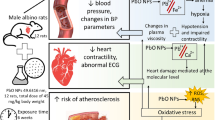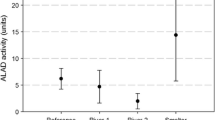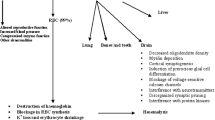Abstract
The interaction between two group IV metals, the highly toxic lead and the relatively inactive and low toxic zirconium, was studied in the bone marrow chromosomes ofMus musculus in vivo. Low and high doses of zirconium oxychloride were fed orally to the experimental mice (i) 2 h before, (ii) 2 h after or (iii) together with different doses of lead nitrate. Protection against lead-induced clastogenicity was observed only when the lower dose of zirconium was administered prior to lead. All other combinations gave an additive or synergistic effect as was seen by significant increases in the frequencies of chromosomal aberrations.
Similar content being viewed by others
References
Browning E. (1969) In:Toxicity of Industrial Metals, 2nd edn. London: Butterworths.
Chakraborty I, Talukder G, Sharma A. 1987. Antagonistic and synergistic effects of lead and selenium inRattus norvegicus.Toxicol Lett 37, 21–26.
Chakraborty I, Sharma A, Talukder G. 1989 Genotoxic effects of lead in mammals.The Nucleus 32, 12–22.
Congiu L, Corongiu FP, Dore M, et al. 1979 The effect of lead nitrate on the tissue distribution of mercury in rats treated with methyl-mercury chloride.Toxicol Appl Pharmacol 51, 363–366.
Couture P., Blaise C, Cluis D, Bastien C. 1989 Zirconium toxicity assessment using bacteria, algae and fish assays.Water Air Soil Pollut 47, 87–100.
Cuddihy RG, Finch GL, Newton GL et al. 1989 Characteristics of radioactive particles released from the Chernobyl nuclear reactor.Environ Sci Technol 23, 89–95.
De Longeas JL, Burnel D, Netler P, et al. 1983 Toxicity and pharmacokinetics of zirconium oxychloride in the mouse and in the rats.Lab Pharmacol 14, 437–447.
Dhir H, Talukder G, Sharma A. 1985a Comparison of cytotoxic effects of lead following acute and chronic treatments in mammalian system.Proc Natl Acad Sci (India) 55B III, 209–215.
Dhir H, Sharma A, Talukder G. 1985b Alteration of cytotoxic effects of lead through interaction with other heavy metals.The Nucleus 28, 68–89.
Dhir H, Roy AK, Sharma A, Talukder G. 1990 Modification of clastogenicity of lead and aluminium in mouse bone marrow cells by dietary ingestion ofPhyllanthus emblica fruit extract.Mutat Res 241, 305–312.
Epstein WL, 1971 Metal induced granulomatous hypersensitivity in man.Adv Biol Skin 11, 313–335.
Ghosh S, Sharma A, Talukder G. 1990 Cytotoxic effects of zirconium oxychloride on bone marrow cells of mice.Mutat Res 243, 29–33.
Ghosh S, Sharma A, Talukder G. 1991 Relationship of clastogenic effects of zirconium oxychloride to dose and duration of exposure in bone marrow cells of micein vivo.Toxicol Lett 55, 195–201.
Hickey RJ, Clelland RC, Boyer DE, Bowers EJ. 1974 Atmospheric sulphur dioxide, nitrogen and lead as mutagenic hazards to human health.Mutat Res 26, 445–446.
Kosower NS, Kosower EM. 1976 The glutathione-glutathione disulphide system. In:Free Radicals in Biology. New York: Academic Press.
Kotz S, Johnson NL. 1982 In:Encyclopedia of Statistical Sciences, Vol. 2. New York: Wiley; 424–425.
Margolin BH, Resnick MA, Rimpo LY, et al. 1986 Statistical analysis ofin vitro cytogenetic assays using Chinese hamster ovary cells.Environ Mutagen 8, 183–204.
Omoto M, Imai T, Seki K, Nomura R, Hirai M. 1988 Effects of ethanol and lead on mouse chromosomes.Jpn J Alcohol Stud Drug Depend 23, 137–146.
Osanai T, Hayakawa K, Kikuchi N, et al. 1989 Investigation of interference by inorganic phosphate on co-precipitation of cadmium, copper, manganese and lead in water with zirconium hydroxide.Eisei Kagaku 35, 297–300.
Preston RJ, Dean BJ, Galloway S, et al. 1987. Mammalianin vivo cytogenetic assays: analysis of chromosome aberrations in bone marrow cells.Mutat Res 189, 157–165.
Rasheva V. 1990 Investigation of the clastogenic effect of lead nitrate on mice.Genet Sel 23, 170–177.
Schroeder HA, Balassa JJ. 1966 Abnormal trace metals in man: zirconium.J Chron Dis 19, 573–586.
Sharma A, Talukder G. 1987 Effects of metals on chromosomes of higher organisms.Environ Mutagen 9, 191–226.
Sokal RR, Rohlf FJ. 1973 Introduction to analysis of variance.In:Introduction to Biostatistics. San Francisco, Freeman; 134–160.
Tice RR, Boucher R, Luke CA, Shelby MD. 1987 Comparative cytogenetic analysis of bone marrow damage induced in male B6C3F mice by multiple exposure to gaseous, 1,3-butadiene.Environ Mutagen 9, 235–250.
Venugopal B, Luckey TD, eds. 1978Metal toxicity in Mammals, Vol. 2. New York: Plenum Press.
Author information
Authors and Affiliations
Rights and permissions
About this article
Cite this article
Dhir, H., Ghosh, S., Sharma, A. et al. Interaction between two group IV metals-lead and zirconium-in bone marrow cells ofMus musculus in vivo . Biometals 5, 81–86 (1992). https://doi.org/10.1007/BF01062218
Received:
Revised:
Issue Date:
DOI: https://doi.org/10.1007/BF01062218




